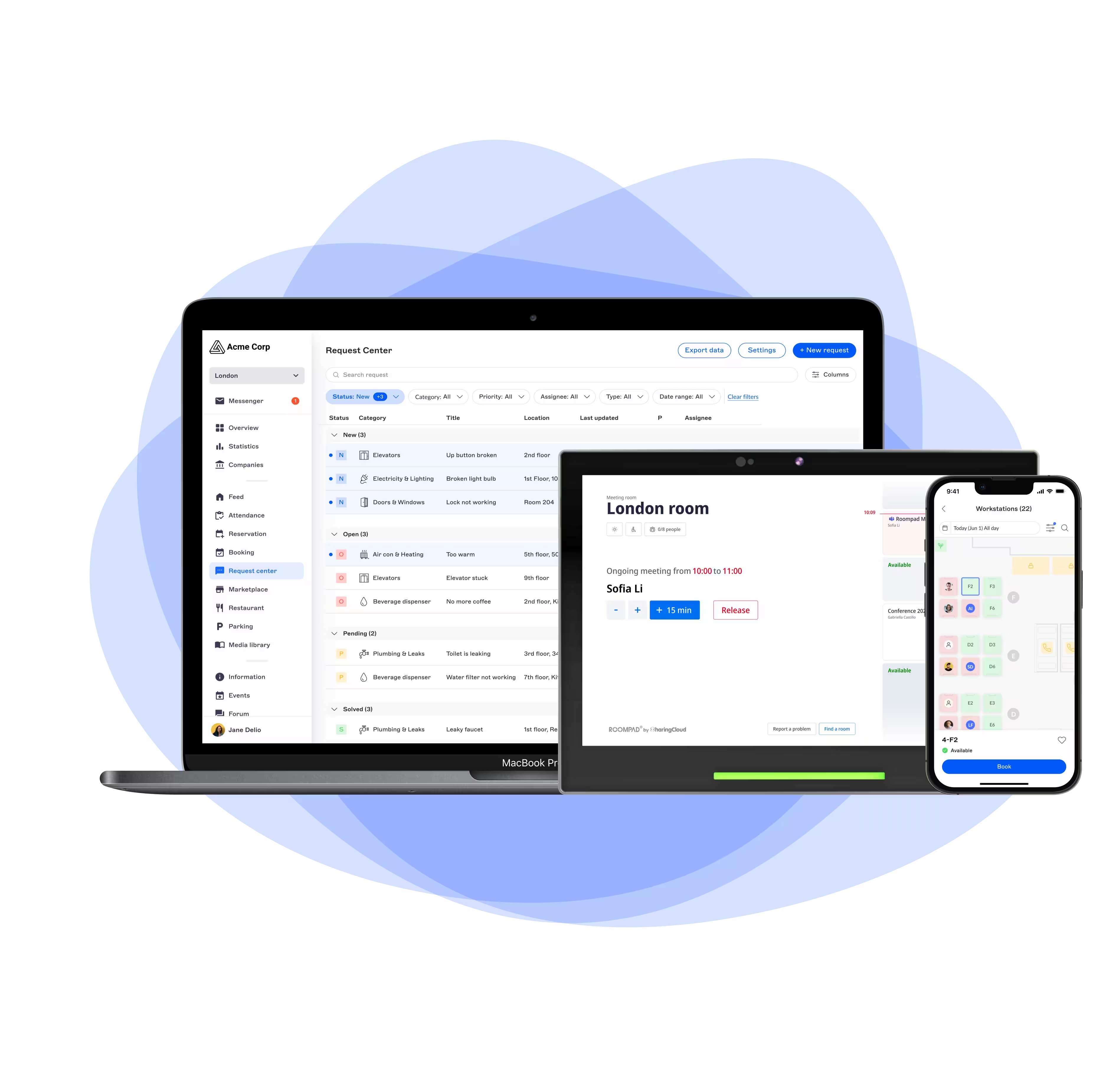Hybrid work management

Table of contents
A hybrid workplace is a work environment that combines elements of traditional in-office work with remote or flexible work arrangements. In a hybrid workplace, employees may have the option to work from home, a co-working space, or another location outside of the office on a regular basis, while still maintaining a presence in the office for meetings, collaboration, and other activities.
The hybrid workplace model is becoming increasingly popular as more companies recognize the benefits of flexible work arrangements, such as improved work-life balance, increased productivity, and reduced overhead costs. It can also allow businesses to attract and retain top talent who may prefer a flexible work environment.
However, the hybrid workplace model also presents challenges, such as the need for effective communication and collaboration among remote and in-office teams, and the need to establish clear policies and guidelines for remote work. Proper management of a hybrid workplace can help ensure its success and the satisfaction of employees.
What is hybrid workplace management?
Hybrid workplace management refers to the strategic planning, coordination and execution of policies and processes to support employees to work effectively in a hybrid work environment. This can include:
- setting policies and guidelines for remote work,
- providing the necessary tools and technology to support remote teams,
- and establishing systems for communication and collaboration among remote and in-office employees.
Supporting employees in their transition to a hybrid work environment, providing training and resources and addressing challenges are also key components of effective hybrid workplace management.
In order to stay flexible and relevant, effective hybrid workplace management involves regularly evaluating the effectiveness of the hybrid work model through employee feedback from employees.
About the Hybrid work Model
The hybrid work model is a type of work arrangement that combines elements of traditional in-office work with remote or flexible work options. In a hybrid work environment, employees may have the option to work from home, a co-working space, or another location outside of the office on a regular basis, while still maintaining a presence in the office for meetings, collaboration, and other activities.
The hybrid work model is becoming increasingly popular as more businesses recognize the benefits of flexible work arrangements. This can include improved work-life balance for employees, increased productivity, and reduced overhead costs for businesses. It can also allow businesses to attract and retain top talent who may prefer a flexible work environment.
In the context of the COVID-19 pandemic, businesses and organizations around the world have implemented measures to protect the health and safety of their employees, such as implementing remote work policies and limiting in-person interactions. This has led to an increase in the number of people working from home, imposing hybrid work models as a new norm adopted today by a majority of businesses.
The Key pillars of an hybrid work model
- Flexibility: organizations allowing hybrid work give their employees the possibility to work from home, a coworking space of any location outside of the office, while still maintaining a presence in the office. This setup can drastically improve work-life balance and support a range of different work styles and preferences.
- Productivity: The hybrid work model has been shown to increase productivity, as employees may feel more engaged and motivated when they have control over their work environment and schedule. Working from home can also reduce distractions and interruptions, allowing employees to feel more productive.
- Communication and collaboration: In a hybrid workplace, effective communication and collaboration are crucial to ensure the success of both in-office and remote teams. This can involve implementing tools and technology to support remote work, such as collaboration software and virtual meeting platforms, as well as establishing clear policies and guidelines for communication and collaboration.
- Management: Proper management of a hybrid workplace is essential to ensure its success. This can involve setting policies and guidelines for remote work, providing the necessary tools and support for remote teams, and offering training and resources to help employees adapt to the hybrid work model.
- Employee satisfaction: The success of the hybrid work model ultimately depends on the satisfaction of employees. By offering a flexible work environment and supporting employees in their transition to the hybrid workplace, businesses can help ensure their satisfaction and success.
{{cta}}
How to manage an hybrid workplace
- Communicate clearly and regularly: clear and regular communication with both in-office and remote teams is key to ensure that everyone is on the same page and aware of expectations and deadlines. This may involve using tools and technology, such as collaboration software and virtual meeting platforms, to support communication and collaboration.
- Establish clear policies and guidelines: to make sure that everyone is aware of their responsibilities and can work effectively in a hybrid work environment, organizations must set clear guidelines such as expectations for attendance and availability, communication and collaboration, and use of technology and equipment.
- Provide training and support: Employees may need training and support to adapt to the hybrid work model, and to support their success and satisfaction in a remote work environment. This may include training on tools and technology, as well as support for mental health and well-being.
- Evaluate and adjust as needed: The effectiveness of the hybrid work model should be regularly evaluated, and feedback from employees should be gathered and considered in making any adjustments to policies and practices. This can help to ensure that the hybrid work model is meeting the needs of both employees and the business.
- Prioritize employee satisfaction: The satisfaction and success of employees should be a top priority in the implementation and management of the hybrid work model. This may involve regular check-ins with employees, listening to their feedback and concerns, and providing support and resources as needed.
What are the main benefits of hybrid workplaces?
- Improved work-life balance: Working from home means less commute time, comfortable and flexible working environment, less crowded workplaces and more time with with family.
- Increased productivity: A lot of employees report being more productive while working from home, mainly because they are less interrupted and they can accommodate their working time to their preferences.
- Reduced costs: With a hybrid work model, organizations can reduce the need for office space and other overhead costs, saving money and increasing profitability. For example, a company of 1000 employees which is able to reduce the size of its office space by 50% thanks to a hybrid work setup could potentially save hundreds of thousands of dollars per year on rent and utilities.
- Reduced emission of greenhouse gas: by reducing the number of people who are driving to and from work each day, hybrid work helps reducing emissions from the transportation sector, which is a major contributor to climate change
- Enhanced collaboration and communication: A hybrid work organization can facilitate collaboration and communication among employees, even when they are not physically present in the same location. This can help to promote teamwork and a sense of community within the organization.
{{cta}}
What are the main challenges of hybrid workplaces?
- Managing remote workers: Organizations might need new approaches to communicate, collaborate, and supervise to ensure that remote workers are productive and engaged. This is why providing the necessary technology and support to help remote teams work effectively is important, as well as establishing systems for communication and collaboration.
- Maintaining the company culture: a lot of companies struggle to maintain a strong company culture when switching to hybrid work. Indeed, as employees may not have as many opportunities to interact with each other in person, they might feel isolated and less engaged.
- Ensuring security: A hybrid work organization may require new measures to ensure the security of sensitive information and data, particularly when employees are working remotely.
- Overcoming resistance to change: The transition to a hybrid work model can be challenging for some employees, who may be resistant to change or uncertain about how to adapt to a new way of working. This can require significant effort to communicate the benefits of the hybrid model and provide support and training to help employees adjust.
Remote work policies in a hybrid workplace
Enforcing remote policies plays a crucial role in the success of a hybrid workplace. They help to establish clear expectations and guidelines as well as support and resources employees need to do their best work while remote. Additionally, remote policies can help to foster a sense of community and connection among employees, even when they are not physically present in the same location. This can help to promote collaboration and communication, which are essential for the success of any organization.
In a hybrid workplace, remote work policies can vary depending on the specific needs and preferences of the organization and its employees. Some common remote work policies that may be enforced in a hybrid workplace include:
- Allowing employees to choose their own work schedule, within certain limits
- Providing employees with the necessary equipment and technology to work remotely
- Establishing clear communication channels and protocols for remote workers
- Providing training and support to help employees adapt to remote work
- Setting expectations for remote workers, such as responding to emails within a certain time frame
- Providing opportunities for remote workers to collaborate and connect with their colleagues in the office
- Regularly reviewing and adjusting remote work policies as needed to ensure they are effective and fair.
Overall, the goal of remote work policies in a hybrid workplace is to support and enable employees to work effectively and efficiently, both in the office and remotely
Hybrid work as a way to retain talents?
Offering employees greater flexibility and control over their work environment is a good way to boost productivity and happiness - and retain talents. Indeed, a company offering a good work-life balance and the ability to work from anywhere is one of the most sought-after perks candidates are looking for nowadays.
Additionally, a hybrid work model can provide employees with the support and resources they need to be successful, which can improve morale and job satisfaction. This can lead to increased retention and loyalty among employees, as they are more likely to stay with an organization that values their well-being and offers them the support they need to thrive. Overall, the hybrid work model can help to retain talent by making the organization more attractive to employees and supporting their success.
Conclusion
The hybrid work model offers a wide range of benefits for businesses and employees.
The combination of traditional in-office work with remote or flexible options offers employees the best of both worlds - a flexible work environment allowing them to be efficient wherever they may be, while still fostering a sense of connection and community.
On the other hand, companies can save on overhead costs such as office space and utilities by allowing their collaborators to work outside of the workplace. Additionally, hybrid work can also lead to increased productivity and employee satisfaction, which can in turn reduce turnover and recruitment costs.
But setting up an effective hybrid workplace is not an overnight process. For a smooth transition, businesses should implement tools and processes to support remote work and establish clear guidelines and policies. Overall, effective communication, thorough planning and commitment to supporting employees will be key.





